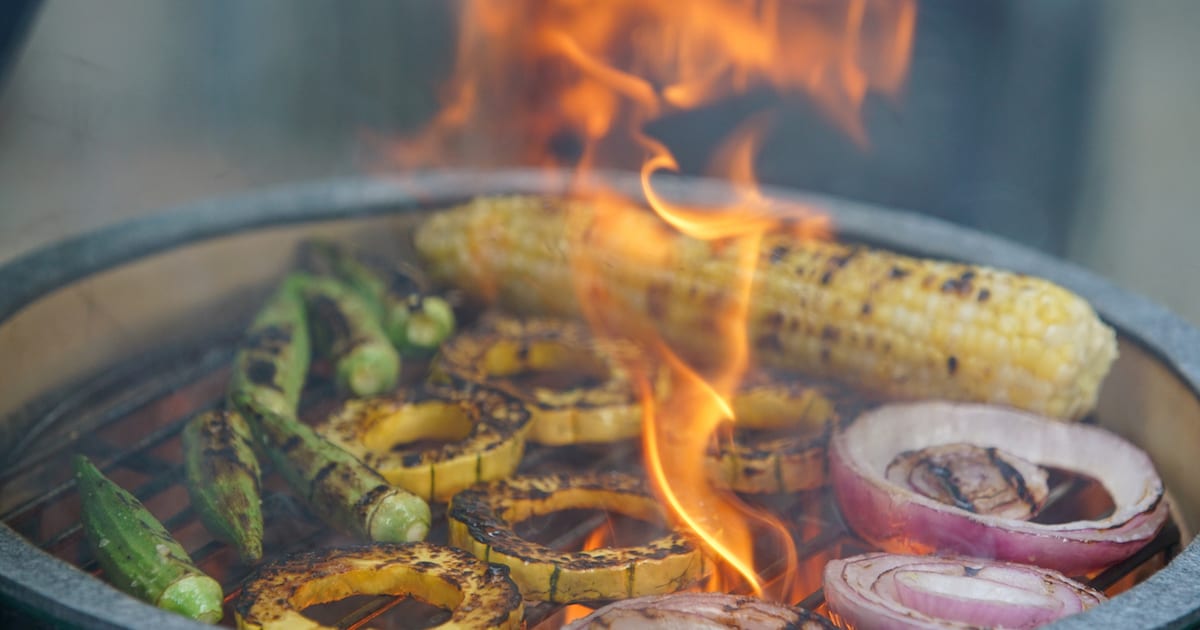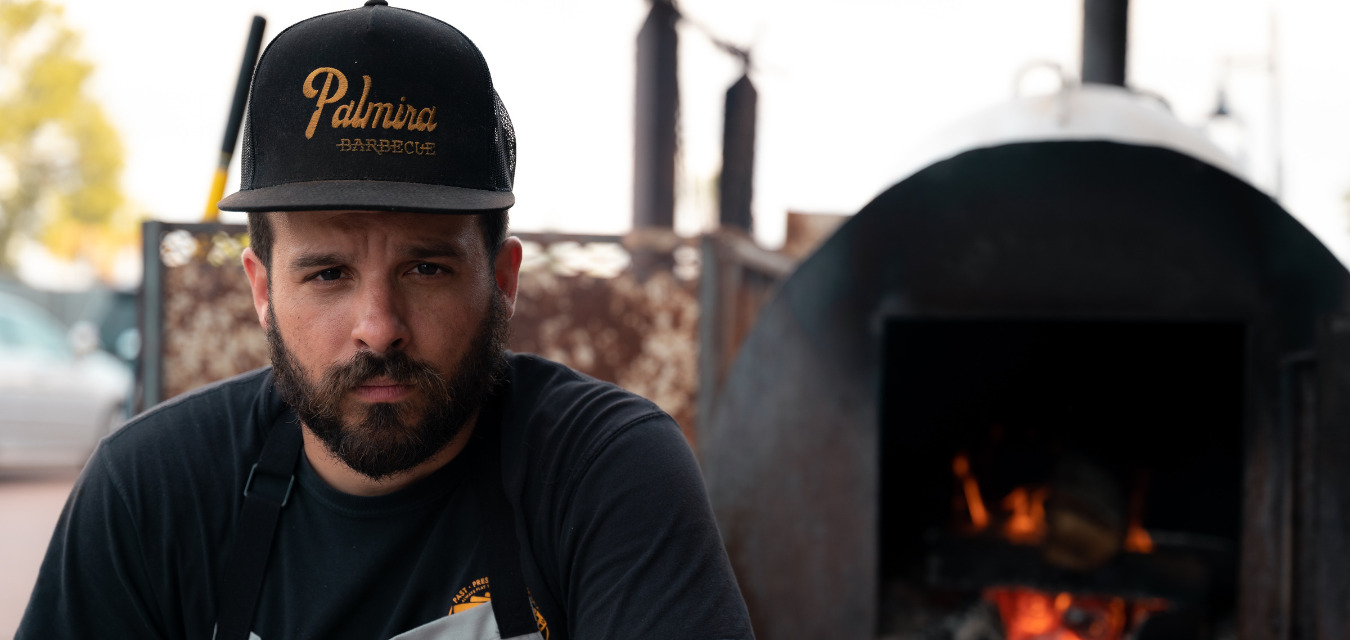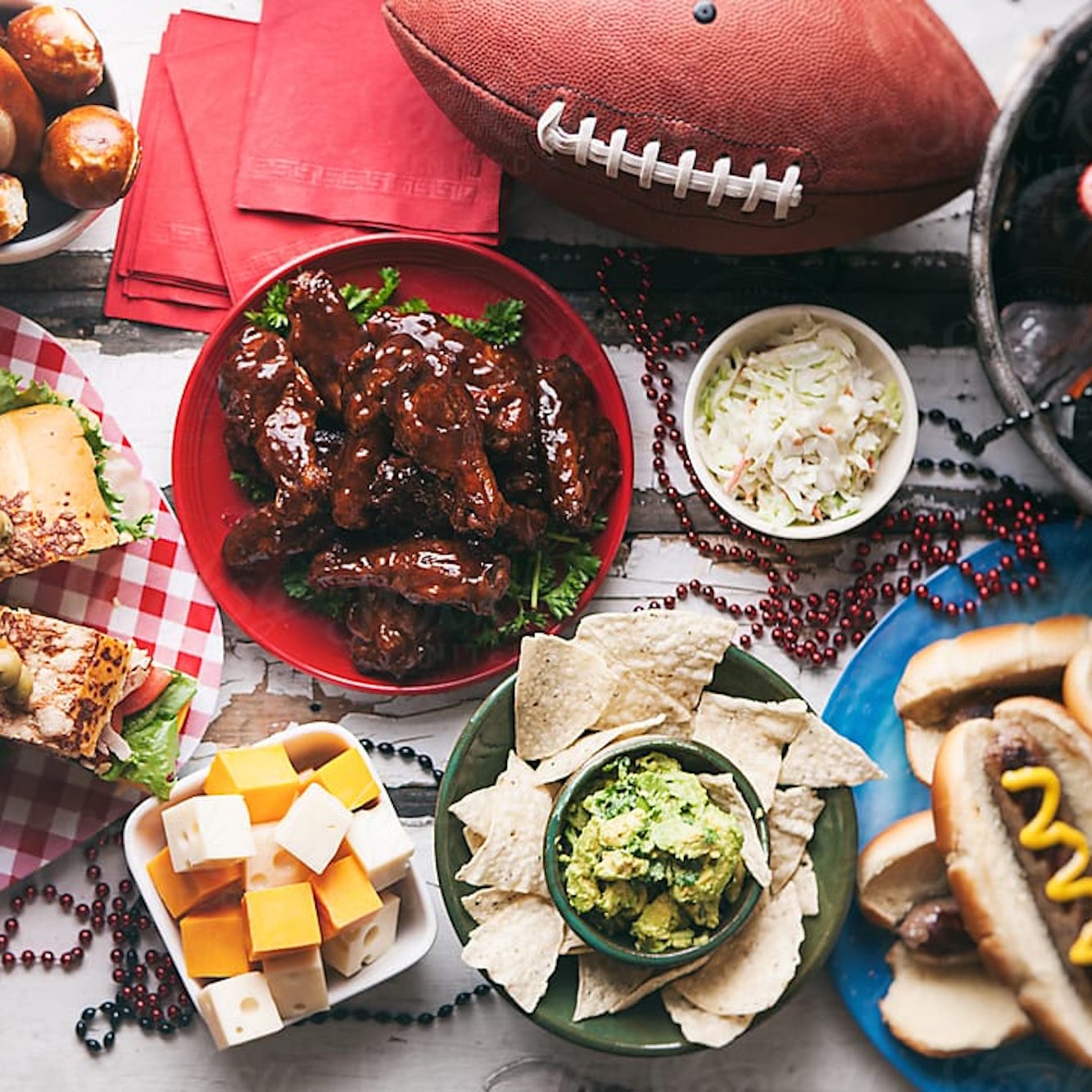Bringing fire to the table in the Queen City
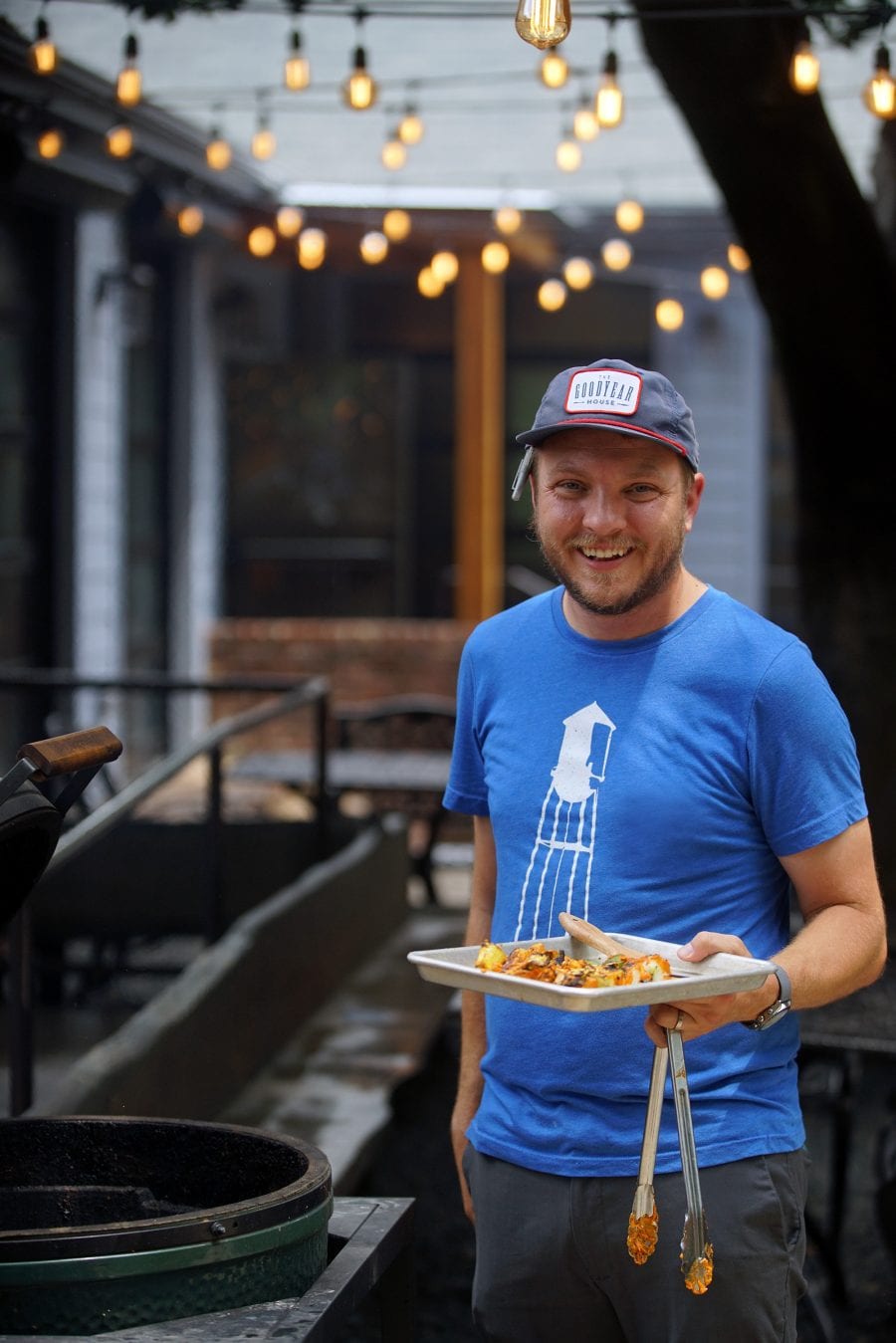
It is no secret that Charlotte, NC loves the grill. On any given Sunday, stepping outside your Queen City residence is often met by the heady aromas of charcoal and barbecue. The grill immediately takes you outdoors and away from the dismal elements of a busy work week. Conversation with friends and family is refreshing, with no pressure or deadlines. With tongs grasped firmly in one hand, a cold beer in the other, and a few tips from Charlotte’s finest professional grillers and pitmasters, you’ll be well on your way. (And, if you’re visiting any of the following restaurants for a taste of their smoke-infused foods, please be sure to check their website for up-to-date hours and regulations.)
Chef Chris Coleman at The Goodyear House says, “cooking with live fire satisfies some primal urge. Building a fire, watching it burn down to coals, coaxing those coals to get to the perfect temperature, and then making adjustments while cooking your meat, seafood, or vegetable is really intense and thoughtful cooking. It’s not nearly as easy as ‘heat pan over medium heat’ or ‘preheat oven to 350.’ It forces you to be cognizant of what’s happening and really be present while cooking.”
THE SCIENCE:
Cooking with fire may not seem so complex. Fundamentally, it’s the simplicity that we all seem to love. However, there is an exact science and an artful balance–and certainly a “method to the madness.”
“Fire brings people together. When you see a live fire, whether in someone’s backyard, a commercial kitchen, or at a campsite, you can’t help but gravitate toward it,” says chef Craig Balch of The Crunkleton.
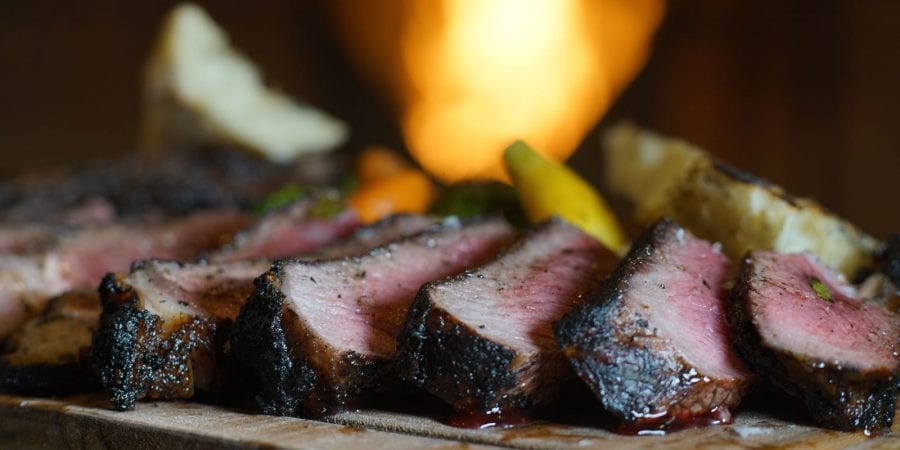
GET PREPARED:
First, your food must be prepared properly. Many Charlotte chefs who are grillers and pitmasters prefer basics seasonings: salt and pepper. Bringing your meat to room temperature is also key. At Baku, in South Park, General Manager Sara Reeves offers a unique way of temping their yakitori (Japanese skewers). “If you look above our Yaku grill, you’ll see metal racks. Before the yakitori touch the grill, we place them on the top rack, then move them closer to the grill, level by level, in order to warm them up to room temperature.”
GET HOT:
Heating up the grill is an important next step. Wood, charcoal, or both? It’s all up to you. Chef Craig Deihl, from Hello, Sailor in Cornelius points out that “the main difference between wood and charcoal is simply that charcoal is more manageable, especially for a kettle grill or ceramic grill. We like to add hickory wood chips to the coal in our BGE for that smoke flavor. Using wood on its own definitely requires constant attention.”
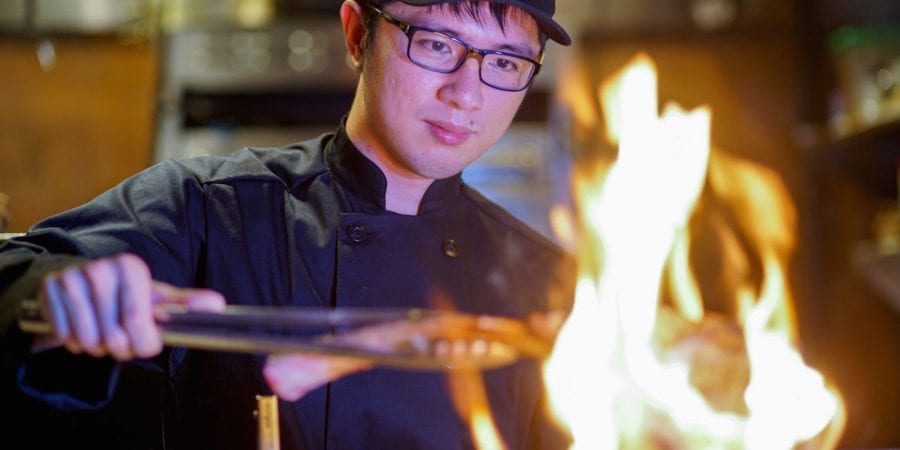
The standard charcoal used in the industry is hardwood, such as oak or maple. Leo Zheng, Robata Yaki Chef at Baku, prefers to use binchotan, a specialty type of charcoal imported from Japan and made from Japanese Oak. In his opinion, “Binchotan is cleaner and has very little dust.” For smoking, Chef Lewis Donald from Sweet Lew’s BBQ recommends a combination of hickory and pecan.
How do you know if your grill is hot enough? Ashley Boyd, Culinary director at 300 East says it’s all about the feel. “For direct heat grilling at home, the standard advice is to assess the temperature of your fire by holding your hand about five inches over the grate. If you have to pull your hand away after just a few seconds, you have high heat. If you can hold your hand there for around six seconds, the heat is medium, and if you can stand to keep your hand in place longer, eight to ten seconds, your grill is cooking at low heat.
GRILLED or SMOKED:
We asked Chef Jim Noble, from Rooster’s Wood Fired Kitchen in South Park to explain the difference between grilling and smoking. “When you’re grilling, you’re trying to keep the meat from getting an overly smoky flavor, and when you’re smoking you obviously want the smoke flavor to come through. The smoky flavor you get while smoking comes from holding the smoke on top of the meat in the smoking chamber for several hours and keeping it at a lower temperature. Whereas when you grill, you’re using a much higher temperature (700+ degrees versus 275 degrees) for a much shorter amount of time.”
For those at home, Chef Lewis from Sweet Lew’s BBQ recommends an off-set smoker as opposed to the more expensive ceramic grills, although many chefs in Charlotte use a Big Green Egg if their kitchen does not already have a built-in, live-fire grill.
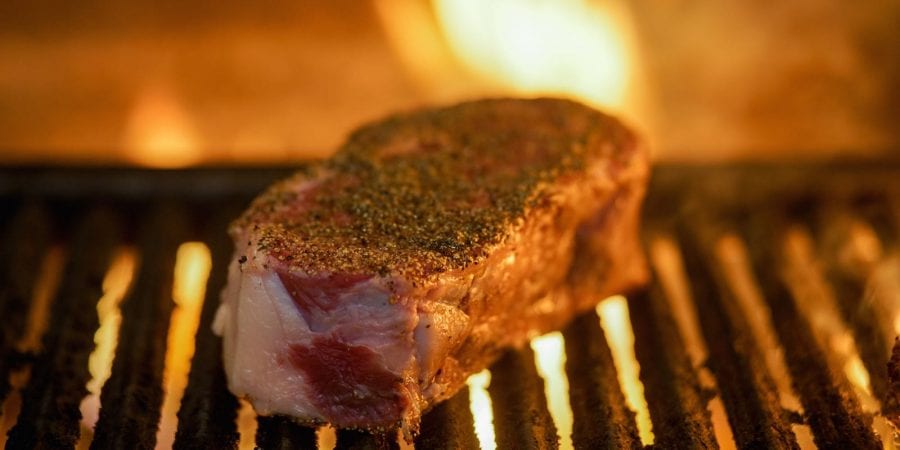
ARE WE THERE YET:
Working with meat, many chefs recommend a thermometer to gauge internal temperature. For those working sans thermometer, Chef Greg Balch says doneness will “depend on the cut of meat and its thickness. For your average one-inch thick cut of ribeye I would say on a 500-degree Fahrenheit grill [it should be] three to four minutes on each side and then check by poking the meat with your finger. You know what raw feels like and you know what your ideal steak feels like when you touch it with a knife. [Once cooked], it should bounce back like the webbing between your pointer finger and thumb when your hand is all the way open, all fingers spread out.”
When working with fish, Chef Jeff Thompson from Legion Brewing in South Park, says to look for “flakiness” by testing it with a fork at its thickest point. Fish will flake easily when it’s done.
For vegetables, the name of the game is hot and brief. Chef Chris Coleman prefers to put his veggie skewers directly on a grate touching hot coals, then pull them off once they start to show grill marks and a bit of caramelization. “I want tenderness on the outside of the vegetable, and a nice ‘bite’ on the inside, to show off its natural crunch.”
THE FLAVOR:
Besides the general “cool factor” that goes with the joy of grilling, what are we getting out of it? Most chefs will tell you that they’re looking for two things: texture and flavor.
“Flavor. Hands down. Doesn’t matter what you are cooking: vegetables, proteins, or pizza. The flavor from a wood fire is a whole different world. That ‘campfire’ taste really adds a layer of complexity. It kind of allows the savory flavors to linger,” says Chef Brittany Cochran, of Stagioni: Four Seasons of Food in the Myers Park neighborhood.
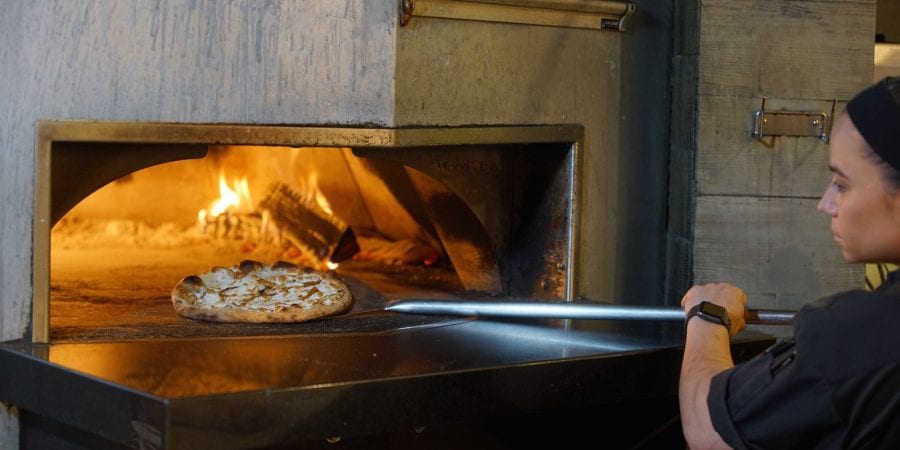
What defines a good smoke flavor? “I would almost describe smoke flavor like the peat in a scotch. It’s earthy and intense,” says Chef Craig Diehl from Hello, Sailor.
Both Chef Chris Coleman and Chef Ashley Boyd use a Big Green Egg to smoke their protein or vegetable in order to add depth and earthiness to their fall and winter dishes, such as stews and braises. “We’re looking for the same flavor profile in our fish (typically salmon, swordfish, or grouper). We want smoky flavor, those signature grill marks, and tender, flaky fish. Cooking fish over the live fire is honestly ideal, because the fish itself cooks faster, therefore retaining moisture,” says Chef Jeff Thompson of Legion Brewing in South Park.
Working with cocktails, Bar Manager Justin Hazelton from Leah & Louise extends his own perspective: “Bourbon is aged in newly charred oak barrels, so in theory the flavor of bourbon is partly made from fire and smoke.” Though bourbon is what we traditionally think of for getting smoky notes into a cocktail, Justin says he also experiments with aged rum, barrel aged gin, reposado, añejo tequila, and mezcals. He points out that “applying fire, in most cases, will round out and darken those brighter flavors you find in fresh citrus and aromatic flowers.”
THE TRADITION:
Why does it feel so good to grill? What makes it so special? The satisfaction of being outdoors, recreating fond childhood barbecue memories, and being part of something that brings people together.
When asked about grilling at the restaurant, Chef Greg Balch quickly cheers: “It feels like I’m camping, and 200 hungry people just walked in the door!”
“I love the atmosphere that smoke in the air creates. There’s a connection to nature and the outdoors. It reminds me of my childhood,” says Chef Ashley Boyd.
“I’m really honoring a tradition here,” says Chef Lewis of Sweet Lew’s BBQ in NoDa. “I wouldn’t be here today without 1940’s legends [Skylight Inn], with its Eastern Carolina whole hog and Charlie Vergo’s Rendezvous, with its Memphis ribs. In the last five to eight years, barbecue and live-fire grilling has been growing fast in Charlotte’s restaurant industry. To me, a lot of restaurants are just doing it for the margin [ie: the money], instead of the love of the process. You know, it’s the purest form of cooking, and you have to focus on that. I tell people all the time, I don’t own a restaurant, I own a BBQ shack.” For Chef Lewis, keeping his concept small and specialized helps him focus on what is most important: The tradition, the food, and the people.
Using smoke in the kitchen, though, hasn’t always been a tradition in Charlotte-area restaurants, notes Chef Jim Noble. “When I started using wood fire in High Point back in ‘84, not a lot of other restaurants were doing it at the time. You really only saw that kind of cooking on the West Coast and Texas.”
Now, the tradition of cooking with fire is here to stay in Charlotte. And as Chef Chris Coleman points out: “We aren’t reinventing the wheel; we look at what generations have done before us and take that knowledge with our flavor profiles and make tasty food.”
Meet the Chefs of Charlotte
Chef Chris Coleman
Locally-sourced southern food in a restored mill home, in the heart of NoDa. Grab a table indoors or enjoy the fresh air on their extensive patio.
3032 N. Davidson St., Charlotte, NC 28205
Bar Manager Justin Hazelton
A modern juke joint with a full bar and a menu that focuses on Mississippi River Valley foodways: Memphis, Jackson, Mississippi, and New Orleans.
Camp North End, 301 Camp Rd., Charlotte, NC 28206
Pitmaster Lewis Donald
BBQ roadside shack, owned by an old soul. Order by the pound or plate.
923 Belmont Ave., Charlotte, NC 28205
Culinary Director Ashley Boyd
An established eatery located in an historic home-turned-restaurant in Charlotte’s Dilworth neighborhood.
300 East Blvd., Charlotte, NC 28203
Chef Leo Zheng
General Manager Sara Reeves
A Robata lounge focused on the live-fire Yaku grill, sushi, and modern cocktails.
4515 Sharon Rd., Charlotte, NC 28211
Chef Greg Balch
Classic cocktail bar with a wide selection of spirits, accompanied by live-fire cooking in Charlotte’s historic Elizabeth neighborhood.
1957 E 7th St., Charlotte, NC 28204
Chef Jeff Thompson
One of Charlotte’s many craft breweries, uniquely featuring a full menu and live-fire grilling.
5610 Carnegie Blvd., Charlotte, NC 28209
Chef Craig Diehl
A bright and sunny retro, lakeside hang out with a modern menu and bar.
20210 Henderson Rd., Cornelius, NC 28031
Chef Jim Noble
Wood-fired oven, live-fire grill, with an extensive wine menu. Known for their wood-fired rotisserie and grill.
6601 Morrison Blvd., Charlotte, NC 28211
Stagioni, Four Seasons of Food
Chef Brittany Cochran
Farm-to-table Italian focused on seasonal fare, wood-fired pizza, modern cocktails, and an ample wine selection.
715 Providence Rd., Charlotte, NC 28207
keep reading
At the Table
10 Fresh Barbecue Sides to Upgrade the Cookout
Nine southern chefs share their favorite unconventional barbecue sides ranging from zesty kimchi slaw to rich corn pudding.
At the Table
A Barbecue Expert’s Top Tips for Tailgating
Need help with creating the perfect tailgating experience? Michael Letchworth of Sam Jones BBQ has four tips to make it stress free and easy!
Key Ingredient
11 Super Easy Super Bowl Snacks
Get ready to cheer for your team with these game-raising recipes that are sure to win a spot in the Super Bowl snacks lineup.
share
trending content
-
New Restaurants in Arkansas
-
Shrimp and Grits: A History
by Erin Byers Murray -
Tea Cakes, A Brief History
by TLP Editors -
Gullah Geechee Home Cooking
by Erin Byers Murray -
The History of Fajitas
by TLP Editors
More From Dining Out
-
9 Noteworthy Kentucky Restaurants | Listen
-
9 Noteworthy Tennessee Restaurants | Listen
-
A New Home for Lazy Betty
-
Our Top Restaurants of 2023
-
50 Years of Family Recipes at Sperry’s





